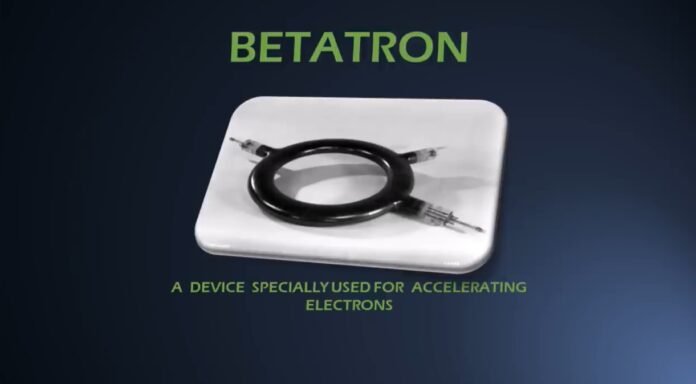The betatron is the particle accelerator that uses an alternating electric field to accelerate electrons and produce high-energy electrons for scientific research and practical applications. Invented in the 1930s, it played a crucial role in advancing our understanding of atomic structure and producing radioactive isotopes for medical, high-energy electrons for scientific research and practical applications.
What is Betatron
A betatron is a kind of particle accelerator that accelerates electrons (also known as beta particles) into high-velocity circular orbits by using the electric field produced by a changing magnetic field. In simple words, an example of a particle accelerator is a betatron, which is used to accelerate electrons. It accelerates electrons to high speeds in a circular orbit using the electric field created by a changing magnetic field. The term “betatron” refers to high-energy electrons, which are also known as “particles”.
Also, the betatron is made out of an evacuated tube that has been bent into a circle and is enclosed in an electromagnet with windings that are parallel to the loop. These windings provide a variable magnetic field that periodically reverses direction due to an alternating electric current. The magnetic field’s direction, strength, and rate of change inside the orbit all have values that are suitable for pushing electrons in one direction during the first quarter of the alternating current cycle.
How Does a Betatron Work?
The betatron works by using a large electromagnet, which creates an alternating electric field, to accelerate electrons. Electrons are injected into the machine, and as they move, they experience a force that causes them to move in a circular path. This force is created by the changing electric field of the electromagnet, and it acts like a “push” on the electrons, causing them to gain energy. The electrons are kept in a circular path by a magnetic field, which keeps them from flying off in a straight line. As the electrons move, they gain energy and reach very high speeds.
Betatron Oscillation
When electrons are injected into the machine, and as they move, they experience a force that causes them to move in a circular path. This force is created by the changing electric field of the electromagnet, and it acts like a “push” on the electrons, causing them to gain energy. The electrons are kept in a circular path by a magnetic field, which keeps them from flying off in a straight line. This process is known as betatron oscillation.These are the steady oscillations in both the horizontal and vertical planes around the equilibrium orbit.
Applications of Betatron
- In the field of high-energy physics, the betatron was used to study the structure of atoms and to learn about the interactions between particles at high energy levels.
- If the electron beam is made to direct on a metal plate, it is used as a source of X-rays and gamma rays.
- The betatron was also used to produce radioactive isotopes for medical and industrial applications. These isotopes are used in cancer treatment and for various industrial processes, such as oil refining and the production of plastics.
- In both industrial and medicinal settings, betatron-produced X-rays are useful.
- Particle physics can make use of very energetic electrons.
- Around 300 MeV of extremely energetic electron beams are produced by the betatron.
- The Betatron is utilized as an X-ray and gamma-ray generator when an electron beam strikes a metal plate.
- X-rays produced by Betatron are widely used in both industrial and medicinal settings.
Limitations of Betatron
- The betatron had some limitations compared to more modern particle accelerators. It was relatively small and could only accelerate electrons to a limited extent, making it less useful for some high-energy physics applications.
- It was not as efficient as more advanced accelerators, such as the synchrotron, which use similar principles but on a much larger scale.
- The strength of the magnetic field is affected by the particle’s maximum energy.
- The magnet’s physical size and iron saturation are the causes of the magnetic field’s degradation.
- Only in a vacuum, the electrons can be accelerated.
- Only a circular vacuum tube is capable of carrying out the process of acceleration.
- When there is a varying magnetic field and a constant electric field, the betatron can function.
- Actually, it is a transformer that acts as the secondary coil of another transformer.
Recommended Articles:
Definition of Beats: Occur, Frequency, Formula, Effect and Applications
Beer-Lambert Law: History, Expression, Derivation and Conditions
Read All About Behaviour Of Gas Molecules
Bell’s Theorem: Definition, Formula, Inequality, Realism, and Theorem
Beta Decay: Introduction, Types, and Theory
The betatron was invented by American physicist Ernest O. Lawrence and his colleagues at the University of California, Berkeley, in the late 1930s. It was the first machine that demonstrated the feasibility of using an alternating electric field to accelerate electrons. Both the betatron and cyclotron are early types of particle accelerators, but they work using different principles. The betatron uses an alternating electric field to accelerate electrons, while the cyclotron uses a magnetic field to keep the charged particles in a circular path while they gain energy. No, the betatron is no longer used today. It has been replaced by more advanced accelerators. The betatron was used for scientific research and practical applications, such as studying the structure of atoms, producing radioactive isotopes for medical and industrial use, and more. The betatron can be used to produce X-rays, as the high-energy electrons produced by the machine can interact with materials to produce X-rays. This was an important application of the betatron in the mid-20th century, and X-rays are still widely used today in medical imaging and other applications. Betatron FAQs
What is the origin of the betatron?
How does the betatron differ from a cyclotron?
Is the betatron still used today?
What was the betatron used for?
What is the relationship between the betatron and X-rays?
